Thai Curry Shrimp Noodles

You’ll be bowled over by this delightful sweet, sour, and salty flavour profile that screams Thai street food. If available, be sure to use tamarind; it infuses the sauce with its remarkable tangy personality. You can find it at most Asian and Indian markets.
2 Tbsp (30 mL) tamarind pulp (or equivalent rice vinegar)
1 cup (250 mL) coconut milk
1 Tbsp (15 mL) fish sauce
1 Tbsp (15 mL) yellow or green curry paste
1 Tbsp (15 mL) coconut sugar or other raw-style sugar
8 oz (225 g) wide rice noodles, preferably brown rice
1 Tbsp (15 mL) coconut oil or peanut oil
1 lb (450 g) organic shrimp
2 garlic cloves, thinly sliced
1 in (2.5 cm) piece fresh ginger, minced
2 cups (500 mL) shredded green or red cabbage
2 cups (500 mL) bean sprouts
2 green onions, white and green parts, thinly sliced
1/3 cup (80 mL) Thai basil or mint, roughly chopped
1/4 cup (60 mL) unsalted roasted peanuts, chopped
1 lime, sliced into wedges
In small bowl, mash together tamarind pulp with 1/4 cup (60 mL) boiling water with fork and let sit for 10 minutes. Press mixture through a fine sieve and reserve tamarind water. Be sure to scrape bottom of sieve to get as much tamarind juice as you can.
Place tamarind water (or rice vinegar), coconut milk, fish sauce, curry paste, and coconut sugar in blender and blend until smooth.
Prepare noodles according to package directions. Drain and rinse well.
Heat oil in large skillet over medium-high heat until shimmering. Add shrimp in single layer and cook without turning until underside is pink, about 3 minutes. Turn and cook until opaque throughout, about 2 minutes more. Remove from pan and add garlic and ginger; cook for 2 minutes. Add coconut milk mixture and simmer for 30 seconds, being sure to scrape any bits that have stuck to skillet bottom.
In large bowl, toss together noodles, cabbage, bean sprouts, green onions, and basil or mint. Divide among serving bowls and top with shrimp and peanuts. Pour sauce over noodles and serve with lime wedges.
Serves 6.
Each serving contains: 388 calories; 21 g protein; 15 g total fat (10 g sat. fat, 0 g trans fat); 44 g total carbohydrates (6 g sugars, 3 g fibre); 498 mg sodium
Source: "Oodles of Noodles", alive #377, March 2014





